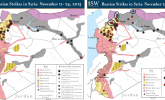 |
 |
Russian Airstrikes in Syria: November 11 - 29, 2015
Nov 29, 2015 - Genevieve Casagrande
Russia shifted its airstrikes in Syria to concentrate along the Turkish border following the downing of a Russian jet by Turkish warplanes on November 24 in an effort to reassert its freedom of action inside Syria. Russian airstrikes focused on the rebel-held Bab al-Hawa and Bab al-Salam border crossings as well as the ISIS-held Jarablus border crossing from November 25 - 29. The Russian Ministry of Defense (MoD) announced the arrival of its advanced S-400 long-range surface-to-air missile (SAM) system at the Bassel al-Assad International Airport in Latakia on November 26 in an effort to deter Turkey from conducting future attacks on Russian warplanes. Additionally, the Russian MoD announced that Russian Su-34 bombers are newly equipped with air-to-air missiles “for providing security of the aircraft of the Russian Aerospace Forces.” Russo-Turkish relations have deteriorated considerably since the incident as Russian Prime Minister Dmitry Medvedev approved an official list of economic sanctions against Turkey on December 1. Turkish officials maintain that Turkey will not offer an apology, asserting that the Turkish Armed Forces took “defensive action” and responded appropriately to the unwarranted Russian airspace violations. Both Russian and Syrian presidents have openly accused Turkey of supporting terrorism in Syria in the wake of the incident. Russian President Vladimir Putin went as far as accusing Turkey of downing the Russian warplane in order to “defend its supplies” of oil from ISIS-held territory in Syria.
The Russian air campaign in Syria otherwise continues to prioritize the preservation of the Assad regime. Russian strikes engaged several civilian targets from November 25 to November 29, emulating the regime’s use of its air power to punish civilian populations. Russia’s strikes along the Turkish border notably struck civilian targets, accomplishing multiple Russian objectives. Russian warplanes conducted at least six rounds of airstrikes targeting convoys of humanitarian aid trucks entering Syria from Turkey in the border town of Azaz in northern Aleppo Province on November 25 and another convoy in the vicinity of the Bab al-Hawa border crossing in northern Idlib on November 28. Local sources claimed that Russian airstrikes also targeted a bakery in Idlib province on November 29, which was reportedly responsible for the distribution of bread to over 45,000 IDPs.
Russia continues to present itself as a decisive actor against ISIS to the international community despite the relative low number of Russian airstrikes targeting ISIS in Syria. Russian airstrikes targeted ISIS-held oil infrastructure in Raqqa and Deir ez-Zour in addition to targeting core ISIS terrain in the northern Aleppo countryside and eastern Homs. Putin asserted that Russia remains “ready to cooperate” with the U.S.-led anti-ISIS coalition on intelligence-sharing measures and other battlefield cooperation in Syria. Putin stated that France and Russia agreed upon bilateral measures to coordinate battlefield activities and share intelligence regarding legitimate targets for airstrikes in Syria following a meeting with French President Francois Hollande on November 26. Putin reportedly requested a map of “forces that are not terrorists and fighting ISIS” during the meeting and pledged to avoid targeting these groups. Such a map would enable Russia to better target the Syrian opposition to the ultimate benefit of the Assad regime.
The following graphic depicts ISW’s assessment of Russian airstrike locations based on reports from local Syrian activist networks, Syrian state-run media, and statements by Russian and Western officials.
High-Confidence reporting. ISW places high confidence in reports corroborated both by official government statements reported through credible channels and documentation from rebel factions or activist networks on the ground in Syria deemed to be credible.
Low-Confidence reporting. ISW places low confidence in secondary sources that have not been confirmed or sources deemed likely to contain disinformation.
